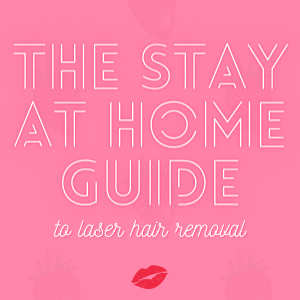After laser hair removal, hair will begin to shed from the hair follicles. Many expect this to be instantaneous, but this is not the case. Shedding after laser hair removal will happen as soon as 5 days after the laser hair removal procedure. This process can take a longer or shorter amount of time depending on your individual hair type, age, hormonal balance, and more. Fortunately, it is possible to speed up shedding after laser hair removal. How to speed up shedding after laser hair removal? Keep reading to find out.
How to Speed Up Shedding After Laser Hair Removal

The Growth Cycle of Hair
Antigen: This is the stage in which hairs are actively growing. This is also the stage that hairs can be effectively treated by laser hair removal. During this stage, the growth of the hair will be visible. The laser will be able to target each hair and destroy the hair follicle.
Catagen: Over time, hairs will naturally fall out of the hair follicle on their own. The stage in which hairs fall out is called the catagen phase. Laser hair removal will not be effective on hairs that are in the catagen phase because the hair is already falling out and cannot be destroyed by the laser.
Telogen: The telogen phase is the resting phase of the hair. During this phase, hairs cannot be treated by laser hair removal because there is no hair growing. The hair follicle is simply at a resting point after the previous hair has fallen out during the catagen phase.
Everyone will have hair at different stages during all times. For some people, hairs will cycle through the different stages more quickly than others. This is why the amount of treatments each person needs for laser hair removal can vary drastically. This is also why you may not notice immediate results after laser hair removal.
If only a small percentage of your hair is in the antigen phase during your laser hair removal treatment, you may not notice a drastic amount of shedding after your treatment because it could only be 10% of your hairs falling out. It is also important to note that it could take several weeks for the hair to fall out after the hair follicle has been destroyed.
While you cannot drastically alter the growth cycle of your hair, it is possible to speed up the growth and shedding process of your hair to an extent. Some may even consider an at-home laser treatment to make the process more convenient.
How to Speed Up Shedding After Laser Hair Removal
In order to speed up shedding after laser hair removal, you can gently exfoliate your skin. Exfoliating will remove dead skin that may be holding the hair follicles in place. Additionally, exfoliating your skin regularly can stimulate the hair follicles and help your hair to move through the growth cycle more quickly, which will also speed up the shedding process.
If you have sensitive skin, it is important to be gentle when exfoliating and refrain from over-exfoliating your skin. Skin does not need to be exfoliated every day but rather a few times a week. Over-exfoliating your skin can irritate your skin. By exfoliating every other day or a few times a week, your skin will be smooth and free of dead cells and hair without becoming irritated.
In order to exfoliate, use a washcloth or loofah and gentle soap or exfoliating scrub. Gently scrub your skin using a circular motion. You do not need to use an excessive amount of pressure. A light amount of pressure is enough to exfoliate without causing damage to the skin.
Many receive laser hair treatment in sensitive and visible areas such as sideburns, so it is important to exercise caution and avoid damaging the skin.
How to Remove Dead Hair Follicles After Laser
If you’re wondering how to remove dead hair follicles after laser treatments, exfoliating is the best option. You may be tempted to pluck or squeeze out dead hairs but this is not recommended. Manually removing the hairs can cause infection, irritation, or ingrown hairs. Additionally, you may remove a hair that was not effectively treated by the laser, meaning that you will disrupt the growth cycle and it may not be treated during your next laser session either.
Laser hair removal treatments require patience. While some people will notice shedding in as little as 5 days, it can take several weeks for others to experience any hair loss. It is best not to interfere with the shedding process aside from gently exfoliating and remember that laser hair removal is a long-term process that may take time but can deliver permanent results.
In order to remove dead hair follicles after laser treatment, gently exfoliate to allow the hairs to shed. If there is any dead skin holding the hair follicle in place, this will remove the dead skin and allow the hair to fall out. This will also stimulate the hair follicles and encourage the shedding and growth process of the hairs.
Hair Stuck in Pores After Laser
In the days or weeks following laser hair removal, treated hairs will begin to emerge from the hair follicles and fall out. It will look like the hairs are growing but in reality they are falling out. Occasionally, the hairs may get stuck under the skin and appear similar to ingrown hairs.
Some may be tempted to pluck or squeeze at the hair follicles when this happens but it is best to refrain from doing so. This could cause irritation or infection to your skin or you could mistakenly remove a hair that was not treated and disrupt the growth cycle of the hair.
When hair is stuck in pores after laser hair removal, gently exfoliate the skin to encourage the hairs to emerge to the surface. After a few days, the hairs should naturally emerge to the surface and shed from the skin.
When exfoliating hairs that are stuck in pores, it is important to use gentle, circular motions and remember that it may take several days for the hairs to naturally emerge.
Best Exfoliating Scrub After Laser Hair Removal
If you’re searching for the best exfoliating scrub after laser hair removal, we recommend the KP Bump Eraser Body Scrub made with 10% AHA (Alpha Hydroxy Acid).
The KP Bump Eraser Body Scrub is made with pumice buffing beads that gently remove dead skin, along with lactic and glycerin acids that prevent bacteria buildup and brighten the skin. The KP Bump Eraser Body Scrub also contains Bisabolol which calms the skin and reduces redness and irritation. Additionally, the scrub contains vitamin E oil to hydrate and enhance the healing process of the skin.
The KP Bump Eraser Body Scrub is made without harmful or unnatural ingredients and is tested for sensitive skin. There are no harsh fragrances and the scrub is cruelty free.
If you’re looking for the best exfoliating scrub after laser hair removal, we recommend KP Bump Eraser Body Scrub as a safe and effective product for gentle exfoliating.
FAQ: How to Speed Up Shedding After Laser Hair Removal
Why is my hair not shedding after laser?
If your hair is not shedding after laser treatment, this is likely because the majority of your hair was not in the antigen phase during the shedding process. Only hair that is in the antigen phase will shed after being treated with a laser. It may take several treatments to see significant shedding after laser hair removal because you may need to allow more time for each individual hair to reach the antigen stage.
Additionally, it is important to remember that the shedding process after laser hair removal is not instantaneous. It can take up to a month for the hairs to shed. Laser hair removal requires patience for results, but with time the results will likely prove themselves to be worth the wait.
Is it OK to pull hair out after laser?
It is not recommended to pull hair out after laser treatments. Pulling hair out after laser treatments can irritate the hairs, especially if they have just been treated. The hairs that were treated by the laser will naturally fall out in the days and weeks following treatment.
It may be tempting to pull hair out after the laser treatment, but not only can it cause irritation and infection, it can also disrupt the growth process of the hair, thus, preventing the laser hair removal process from being as effective during your next session. If you pull a hair out, you restart the growth process of your hair.
Depending on your individual growth cycle, the hair could stay in the telogen, or resting phase, for a while after being pulled. If the hair is in the telogen phase during your next laser hair removal treatment, the hair will not be able to be treated by the laser and will eventually grow back.
How long does it take the hair to shed after laser?
The amount of time it takes for hair to shed after a laser treatment can vary drastically from one person to the next. Some people may notice hairs shedding just days after treatment while others may not notice any shedding for up to a month.
The results vary based on the individual hair growth cycle, hair type, age, and hormones of a person.
How can you tell if laser hair removal is working?
There are several signs to watch out for to see if laser hair removal is working for you. These signs are as follows:
- Hair is growing back more slowly. If laser hair removal is working, hairs will be slower to grow back. This means that hairs from each stage and growth cycle are slowly being destroyed, leaving less hair to grow back. As hairs end their resting stages and enter the antigen stage, less and less hair will resurface.
- Hair is becoming thinner and lighter. If laser hair removal is working, your hair will become thinner and lighter. This is because the large, thicker hairs are the easiest to remove by laser and will be the first to go. If you’re noticing thin, light hairs in place of the thicker hair that was once there, you are probably noticing the fine hairs that are more resistant to laser.
- It is easier to shave. If laser hair removal is working, you may have an easier time shaving than you used to. You may find that your razors are lasting longer and that you are able to achieve a clean shave more quickly. This is because there is less and less hair to shave after each treatment.
- You’re experiencing less irritation. Early on in the laser process, you may experience irritation as many hair follicles are being destroyed. Over time, there are less hairs to destroy, thus, your skin will become less irritated.
- You experience no hair for longer amounts of time. If you can now go weeks after your laser session without experiencing any regrowth, this is yet another sign that the laser treatment is working. More and more hair follicles are being destroyed, so there is less hair to grow back.
What does shedding look like after laser hair removal?
Shedding after laser hair removal will look like stubble or hair regrowth. However, it is not actually the hair regrowing, but instead, it is the hair pushing its way out so it can fall out of the skin.
Also, you may see black dots appearing on your skin during the shedding process. Commonly referred to as “pepperspots”, these dots are harmless and should go away on their own. You can exfoliate to help speed this process up.
Final Thoughts: How to Speed Up Shedding After Laser Hair Removal
If you’re wondering how to speed up shedding after laser hair removal, it is important to remember that the hair will fall out over time in accordance to the growth cycle and individual state of your hair follicles. In order to safely speed up the shedding process, you can gently exfoliate the skin using our recommended exfoliant. Laser hair removal requires patience, but can deliver amazing results with time.







